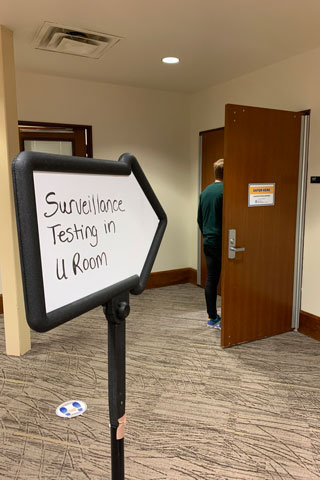COVID-19 tracing team stands ready
Staff members volunteer to fill vital role

When the University of Pittsburgh at Bradford needed to create a contact tracing team this summer to help mitigate the spread of the coronavirus, several employees quickly volunteered to serve in that new role.
Thirteen staff members at Pitt-Bradford, most from the university’s athletic department, volunteered to serve as contact tracers when the availability of contact tracing in the area was uncertain. Athletics staff members had the time and the campus knowledge to serve in this new role, particularly since Pitt-Bradford’s NCAA Division III athletics was postponed for the fall semester.
Leading the team are athletic trainers Dane Renwick and Heidi Lucke, who also have the benefit of some medical background. In addition to the athletics staff, two staff members from other offices on campus have joined the contact tracing team.
“I am proud of our athletics staff and our colleagues in other offices who have stepped up to fill this new and important role,” said Bret Butler, director of intercollegiate athletics and recreation. “They are performing a valuable service to help keep our campus community – and our friends in the surrounding community – healthy and safe.”
Before joining the team, each member completed a 6-hour contact tracing course developed by Johns Hopkins University. The course included information about COVID-19 and its symptoms and infectious periods.
The team also learned how to effectively collect information from those who test positive for the virus and how to explain isolation and quarantine procedures to those who have come in close contact with someone with a suspected or confirmed positive COVID-19 case.
Currently, there are no positive cases on the Bradford campus. A second round of surveillance testing was conducted today. If any positive cases are identified as a result, the contact tracing team will mobilize immediately to initiate the process.
“Contact tracing is vital in keeping our campus safe,” said Nicole Stark, director of Student Health Services. “The contact tracing team collects the detailed information we need to promptly respond and enact the various steps of the isolation and quarantine protocols. It truly is a team effort.”
Team members have already traced contacts for some members of the Pitt-Bradford community who were ill and tested for COVID-19. To date, all of those tests were negative.
The process starts when a student reports to Student Health Services that they’re feeling ill. A nurse in Student Health Services will assess their symptoms and consult with a provider at the campus physician’s office. If a COVID-19 test is ordered, the student will administer the test, and the campus nurse will collect the test sample and immediately initiate the isolation protocol.
“An infected person can spread COVID-19 starting from 48 hours before the person has any symptoms or test positive for COVID-19,” Stark said.
Therefore, while waiting the one to two days before test results come back, contact tracers call the isolated person and ask them a series of questions to determine when they began to feel ill and every person they might have come into close contact with during the previous two days.
Close contact is defined as spending more than 15 minutes at a distance closer than six feet. Contact tracers then call those people who were in contact with the sick person.
Ill students are placed in isolation, and close contacts are quarantined. The university has set aside 36 beds to use for isolating and quarantining students.
To support those in isolation or quarantine, staff members check on their symptoms daily and deliver food to them. Students who still feel well enough may attend classes remotely, an option made available this fall thanks to the Flex@Pitt model.
The university’s protocols were developed in close consultation with the University of Pittsburgh’s COVID-19 Medical Response Office, which is made up of physicians and researchers from the Pitt medical school. The medical response office has worked closely with many Pitt-Bradford employees to guide them on other coronavirus safety measures such as physical distancing and face covering requirements.
Pitt-Bradford is committed to maintaining the privacy of individuals and will not share information about anyone who has tested positive. Additionally, the university, like the other Pitt campuses, will not announce positive test results. Pitt-Bradford will, however, continue to provide twice-weekly updates to the COVID-19 dashboard on its website regarding the number of confirmed positive cases on campus.
For more information about Pitt-Bradford’s COVID-19 health and safety measures, visit www.upb.pitt.edu/operating-safely.
--30--